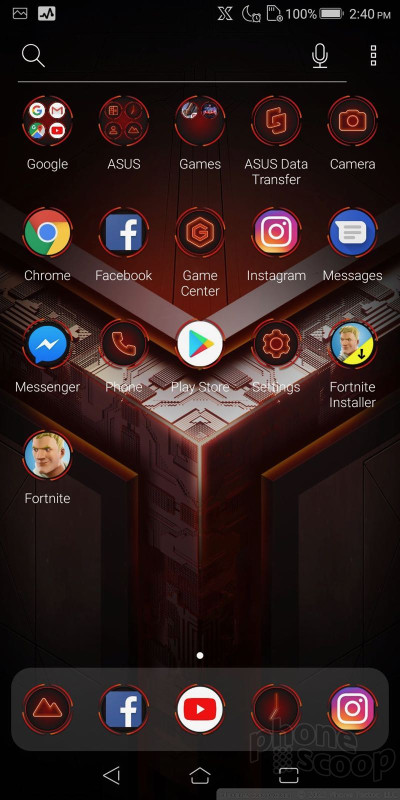Review: Asus ROG Phone
Lock Screen
For all the ridiculous software on this phone, the lock screen experience is pretty simple. Asus calls it the "Always-On Panel." You can choose from three different clock styles. Simple notification badges collect under the clock widget.
As for security, the ROG Phone includes the stock Android functionality buried under Asus' UI skin. The process of recording fingerprints is quite easy, and you can use your print to unlock the phone or to answer calls (thus preventing others from answering your calls.) You can also elect to lock individual apps and files with your fingerprint.
A simple face detection tool is aboard, but it's not secure like Apple's Face ID; a picture of you might fool it. I like that you can choose to use your face to just unlock notifications on the lock screen.
Face Recognition

Home Screens
The ROG Phone runs Android 8 Oreo. The user interface may look extra spiffy thanks to Asus' thick coat of paint, but the mechanics and actual usability should be familiar to most seasoned Android users.
The Google Feed serves as the left-most screen, which I'm happy to see. I like that you can adjust the number of columns and rows of apps that appear on the home screens; whether the icons are aligned with the top or bottom of the screen; as well as tweak the scroll effect, the fonts, icon colors, and even themes.
You can hide apps in the app drawer, as well as load them into folders or arrange them alphabetically or in custom order.
I'll just quickly mention here that the overclocked Snapdragon 845, with 8 GB of RAM, delivers all the performance you could ever ask for in a phone for everyday tasks. Most of the phone's performance is meant for gaming, which I'll cover more in-depth in the gaming section.
Camera
A quick launch feature opens the camera when you double press the volume down button. The camera opens instantly.
The ROG's camera app is on par with those from Samsung and LG. Tweaking any of the basics is a cinch. Both the flash and the HDR functions can be set to on, off, or auto, and there are a handful of timer options. The full settings menu allows you to adjust features like location tagging, timestamps, watermarks, on-screen grids, and the like.
There's a simple selector switch, next to the shutter button, that lets you hop between a standard field of view and a wide-angle field of view.
Thanks in part to the Snapdragon 845, the ROG Phone can handle "AI" functions, such as automatic scene detection. It can recognize 16 different objects/scenes and then adjust the parameters for the best possible results. It does this really quickly.
If you swipe the viewfinder down, you'll get a grid of nine filters. If you swipe up, you can access the various shooting modes. The default is auto, but you'll also find pro (manual), beauty, panorama, time lapse, GIF creator, slow motion, Google Lens, and "super resolution".
The pro mode is pretty powerful. You can adjust white balance, exposure, ISO, shutter speed, and the autofocus. The shutter speed can be set as long as 32 seconds, for high-quality or creative night shots.
The other features work about as you expect them to. The super resolution tool quadruples the 12-megapixel sensor to 48 megapixels with some software trickery. There's nothing difficult about using it; simply put it in super-resolution mode and fire away.
The best part? The camera is lightning fast. This phone has perhaps the fastest camera I've used on an Android phone.
Photos/Video
The ROG Phone has a 12-megapixel Sony IMX363 "dual pixel" image sensor with an aperture of f/1.8. It offers an 83-degree field of view and optical image stabilization. The secondary wide-angle camera has an 8-megapixel sensor with a 120-degree field of view. It also assists when using the portrait function.
The images didn't blow me away, but they are generally good. I saw decent focus and exposure. Color was a little imbalanced, and photos tended to show a bit of grain. Asus claims the phone does well in low light, and I wouldn't disagree. The ROG Phone is not as good as leading devices such as the Note9, Pixel 3, or iPhone Xs, but it's not terribly far off either.
The various shooting modes all deliver results that are close to those of competing phones. The slow-motion only goes as slow as 240fps, while others reach 480fps and even 960fps. The portrait function manages to get the boundary between in-focus and out-of-focus right most of the time. The wide-angle mode will distort your images a bit with a semi-fisheye effect.
The selfie camera can snap portrait-style shots and apply beauty effects at the same time. The results can be garish if you narrow your face too much or make your eyes too big. Selfies with no effects are still solid enough that you won't be embarrassed to share them.
Selfie

The ROG Phone can capture video up to 4K resolution and at varying frame rates. I tested the 1080p and 4K resolutions and came away impressed. The results looked particularly good on the ROG phone's screen.
People who buy this phone aren't likely seeking the best imaging device on the market. Even so, I think they'll be surprised with how decent the photos look.










































































 Hands On with the Asus ROG Phone
Hands On with the Asus ROG Phone
 Asus' ROG Phone Now Available for Preorder
Asus' ROG Phone Now Available for Preorder
 Asus Confirms Plans to Sell ROG Phone In the US for $899
Asus Confirms Plans to Sell ROG Phone In the US for $899
 Asus Implies It Might Sell the ROG Phone in the US
Asus Implies It Might Sell the ROG Phone in the US
 Asus' ROG Smartphone Has Specially Tuned Snapdragon 845 for Blistering Game Performance
Asus' ROG Smartphone Has Specially Tuned Snapdragon 845 for Blistering Game Performance
 Asus ROG Phone
Asus ROG Phone








